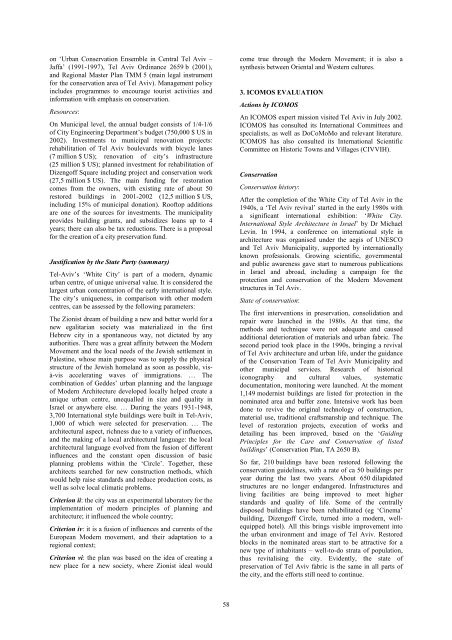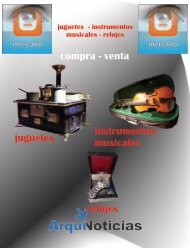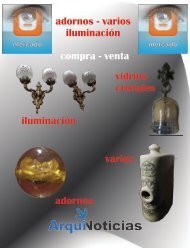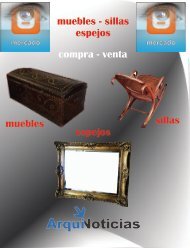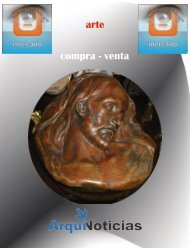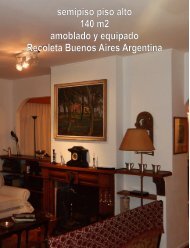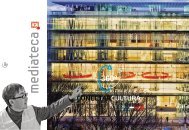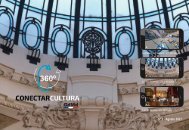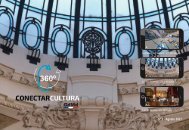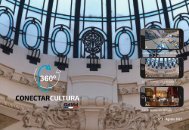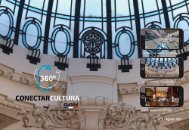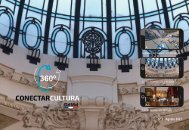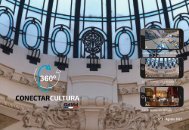White City of Tel-Aviv -- the Modern Movement
Nominación para la UNESCO World heritage
Nominación para la UNESCO World heritage
Create successful ePaper yourself
Turn your PDF publications into a flip-book with our unique Google optimized e-Paper software.
on ‘Urban Conservation Ensemble in Central <strong>Tel</strong> <strong>Aviv</strong> –<br />
Jaffa’ (1991-1997), <strong>Tel</strong> <strong>Aviv</strong> Ordinance 2659 b (2001),<br />
and Regional Master Plan TMM 5 (main legal instrument<br />
for <strong>the</strong> conservation area <strong>of</strong> <strong>Tel</strong> <strong>Aviv</strong>). Management policy<br />
includes programmes to encourage tourist activities and<br />
information with emphasis on conservation.<br />
Resources:<br />
On Municipal level, <strong>the</strong> annual budget consists <strong>of</strong> 1/4-1/6<br />
<strong>of</strong> <strong>City</strong> Engineering Department’s budget (750,000 $ US in<br />
2002). Investments to municipal renovation projects:<br />
rehabilitation <strong>of</strong> <strong>Tel</strong> <strong>Aviv</strong> boulevards with bicycle lanes<br />
(7 million $ US); renovation <strong>of</strong> city’s infrastructure<br />
(25 million $ US); planned investment for rehabilitation <strong>of</strong><br />
Dizeng<strong>of</strong>f Square including project and conservation work<br />
(27,5 million $ US). The main funding for restoration<br />
comes from <strong>the</strong> owners, with existing rate <strong>of</strong> about 50<br />
restored buildings in 2001-2002 (12,5 million $ US,<br />
including 15% <strong>of</strong> municipal donation). Ro<strong>of</strong>top additions<br />
are one <strong>of</strong> <strong>the</strong> sources for investments. The municipality<br />
provides building grants, and subsidizes loans up to 4<br />
years; <strong>the</strong>re can also be tax reductions. There is a proposal<br />
for <strong>the</strong> creation <strong>of</strong> a city preservation fund.<br />
Justification by <strong>the</strong> State Party (summary)<br />
<strong>Tel</strong>-<strong>Aviv</strong>’s ‘<strong>White</strong> <strong>City</strong>’ is part <strong>of</strong> a modern, dynamic<br />
urban centre, <strong>of</strong> unique universal value. It is considered <strong>the</strong><br />
largest urban concentration <strong>of</strong> <strong>the</strong> early international style.<br />
The city’s uniqueness, in comparison with o<strong>the</strong>r modern<br />
centres, can be assessed by <strong>the</strong> following parameters:<br />
The Zionist dream <strong>of</strong> building a new and better world for a<br />
new egalitarian society was materialized in <strong>the</strong> first<br />
Hebrew city in a spontaneous way, not dictated by any<br />
authorities. There was a great affinity between <strong>the</strong> <strong>Modern</strong><br />
<strong>Movement</strong> and <strong>the</strong> local needs <strong>of</strong> <strong>the</strong> Jewish settlement in<br />
Palestine, whose main purpose was to supply <strong>the</strong> physical<br />
structure <strong>of</strong> <strong>the</strong> Jewish homeland as soon as possible, visà-vis<br />
accelerating waves <strong>of</strong> immigrations. … The<br />
combination <strong>of</strong> Geddes’ urban planning and <strong>the</strong> language<br />
<strong>of</strong> <strong>Modern</strong> Architecture developed locally helped create a<br />
unique urban centre, unequalled in size and quality in<br />
Israel or anywhere else. … During <strong>the</strong> years 1931-1948,<br />
3,700 International style buildings were built in <strong>Tel</strong>-<strong>Aviv</strong>,<br />
1,000 <strong>of</strong> which were selected for preservation. … The<br />
architectural aspect, richness due to a variety <strong>of</strong> influences,<br />
and <strong>the</strong> making <strong>of</strong> a local architectural language: <strong>the</strong> local<br />
architectural language evolved from <strong>the</strong> fusion <strong>of</strong> different<br />
influences and <strong>the</strong> constant open discussion <strong>of</strong> basic<br />
planning problems within <strong>the</strong> ‘Circle’. Toge<strong>the</strong>r, <strong>the</strong>se<br />
architects searched for new construction methods, which<br />
would help raise standards and reduce production costs, as<br />
well as solve local climatic problems.<br />
Criterion ii: <strong>the</strong> city was an experimental laboratory for <strong>the</strong><br />
implementation <strong>of</strong> modern principles <strong>of</strong> planning and<br />
architecture; it influenced <strong>the</strong> whole country;<br />
Criterion iv: it is a fusion <strong>of</strong> influences and currents <strong>of</strong> <strong>the</strong><br />
European <strong>Modern</strong> movement, and <strong>the</strong>ir adaptation to a<br />
regional context;<br />
Criterion vi: <strong>the</strong> plan was based on <strong>the</strong> idea <strong>of</strong> creating a<br />
new place for a new society, where Zionist ideal would<br />
come true through <strong>the</strong> <strong>Modern</strong> <strong>Movement</strong>; it is also a<br />
syn<strong>the</strong>sis between Oriental and Western cultures.<br />
3. ICOMOS EVALUATION<br />
Actions by ICOMOS<br />
An ICOMOS expert mission visited <strong>Tel</strong> <strong>Aviv</strong> in July 2002.<br />
ICOMOS has consulted its International Committees and<br />
specialists, as well as DoCoMoMo and relevant literature.<br />
ICOMOS has also consulted its International Scientific<br />
Committee on Historic Towns and Villages (CIVVIH).<br />
Conservation<br />
Conservation history:<br />
After <strong>the</strong> completion <strong>of</strong> <strong>the</strong> <strong>White</strong> <strong>City</strong> <strong>of</strong> <strong>Tel</strong> <strong>Aviv</strong> in <strong>the</strong><br />
1940s, a ‘<strong>Tel</strong> <strong>Aviv</strong> revival’ started in <strong>the</strong> early 1980s with<br />
a significant international exhibition: ‘<strong>White</strong> <strong>City</strong>.<br />
International Style Architecture in Israel’ by Dr Michael<br />
Levin. In 1994, a conference on international style in<br />
architecture was organised under <strong>the</strong> aegis <strong>of</strong> UNESCO<br />
and <strong>Tel</strong> <strong>Aviv</strong> Municipality, supported by internationally<br />
known pr<strong>of</strong>essionals. Growing scientific, governmental<br />
and public awareness gave start to numerous publications<br />
in Israel and abroad, including a campaign for <strong>the</strong><br />
protection and conservation <strong>of</strong> <strong>the</strong> <strong>Modern</strong> <strong>Movement</strong><br />
structures in <strong>Tel</strong> <strong>Aviv</strong>.<br />
State <strong>of</strong> conservation:<br />
The first interventions in preservation, consolidation and<br />
repair were launched in <strong>the</strong> 1980s. At that time, <strong>the</strong><br />
methods and technique were not adequate and caused<br />
additional deterioration <strong>of</strong> materials and urban fabric. The<br />
second period took place in <strong>the</strong> 1990s, bringing a revival<br />
<strong>of</strong> <strong>Tel</strong> <strong>Aviv</strong> architecture and urban life, under <strong>the</strong> guidance<br />
<strong>of</strong> <strong>the</strong> Conservation Team <strong>of</strong> <strong>Tel</strong> <strong>Aviv</strong> Municipality and<br />
o<strong>the</strong>r municipal services. Research <strong>of</strong> historical<br />
iconography and cultural values, systematic<br />
documentation, monitoring were launched. At <strong>the</strong> moment<br />
1,149 modernist buildings are listed for protection in <strong>the</strong><br />
nominated area and buffer zone. Intensive work has been<br />
done to revive <strong>the</strong> original technology <strong>of</strong> construction,<br />
material use, traditional craftsmanship and technique. The<br />
level <strong>of</strong> restoration projects, execution <strong>of</strong> works and<br />
detailing has been improved, based on <strong>the</strong> ‘Guiding<br />
Principles for <strong>the</strong> Care and Conservation <strong>of</strong> listed<br />
buildings’ (Conservation Plan, TA 2650 B).<br />
So far, 210 buildings have been restored following <strong>the</strong><br />
conservation guidelines, with a rate <strong>of</strong> ca 50 buildings per<br />
year during <strong>the</strong> last two years. About 650 dilapidated<br />
structures are no longer endangered. Infrastructures and<br />
living facilities are being improved to meet higher<br />
standards and quality <strong>of</strong> life. Some <strong>of</strong> <strong>the</strong> centrally<br />
disposed buildings have been rehabilitated (eg ‘Cinema’<br />
building, Dizeng<strong>of</strong>f Circle, turned into a modern, wellequipped<br />
hotel). All this brings visible improvement into<br />
<strong>the</strong> urban environment and image <strong>of</strong> <strong>Tel</strong> <strong>Aviv</strong>. Restored<br />
blocks in <strong>the</strong> nominated areas start to be attractive for a<br />
new type <strong>of</strong> inhabitants – well-to-do strata <strong>of</strong> population,<br />
thus revitalising <strong>the</strong> city. Evidently, <strong>the</strong> state <strong>of</strong><br />
preservation <strong>of</strong> <strong>Tel</strong> <strong>Aviv</strong> fabric is <strong>the</strong> same in all parts <strong>of</strong><br />
<strong>the</strong> city, and <strong>the</strong> efforts still need to continue.<br />
58


